When I first moved onto our current property four years ago, I tilled and planted a large garden to help us become more self-sufficient. At about the same time, I started studying wild edibles. There was a large plant growing near our barn that I did not recognize. The leaves were about a foot long and spade shaped. The stalks vaguely resembled rhubarb. I did some research and found out that this large plant was called wild burdock.
Of course, my first instinct was to find out if the plant was edible. It could be a huge sustainable food source for my family if it was. As is with most wild plants, there were mixed answers regarding its toxicity. Some people said to stay away completely, while others said that most of the plant is edible if prepared properly. I found out for myself during a springtime, knife-only survival challenge. Because the only tool I brought with me was a knife and it rained the whole time, I could not start a fire to cook fish or other animals. The risk of getting sick was too great for me to eat the meat raw. I was forced to rely on wild edibles to survive.
Related: Burdock: The Annoying Weed That Can Save Your Life
After constructing my lean-to shelter and gathering some rain water, I decided to head out for food. I found lots of dandelion, clover, wood sorrel, plantain, chickweed, and violets. There were a few wild carrots, but I needed something more substantial. Burdock was my solution. I used my knife to dig up the large root and shave off the skin. In this case, I ate the root raw for some needed calories and carbohydrates. It tasted like a cross between a carrot and a potato, and it was just what I needed to make it through my survival challenge. However, in this article I am going to cover ways to harvest and cook burdock so you can more easily incorporate this plant into your weekly diet.
Harvesting
First, you want to try and target young burdock plants. While you will not get as much food out of the plant, it will be a softer plant. Find a large patch of burdock and only harvest the amount you currently need. If you do not wipe out the patch, it can continue to thrive and provide food for your family. 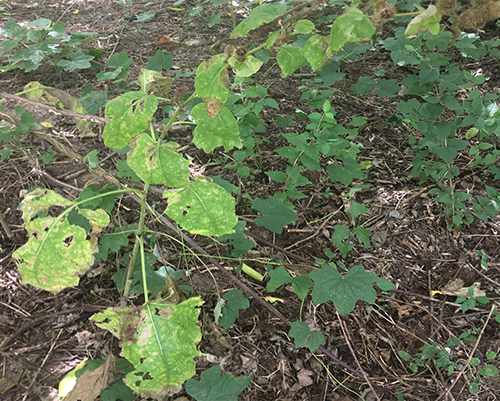
Push aside the leaves and follow the stem down to the ground. 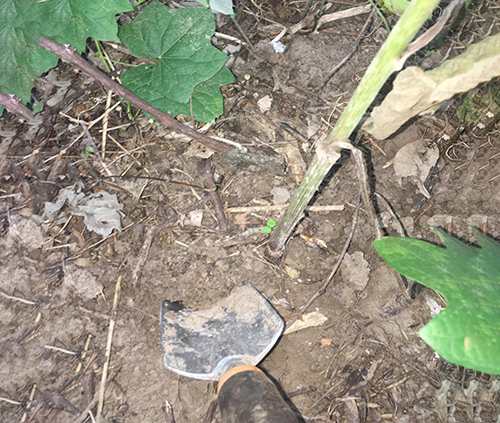 Carefully dig the dirt away from around the root.
Carefully dig the dirt away from around the root.
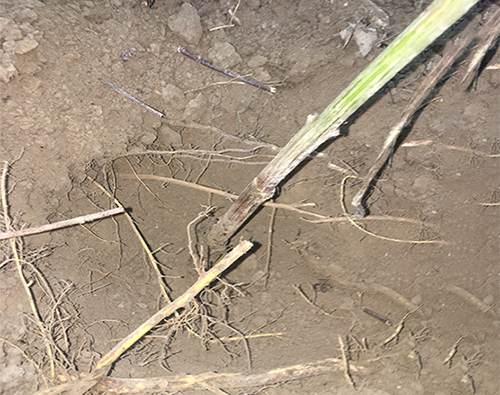 It is common for the root to be over a foot long, so be sure not to accidentally cut through it with your digging tool.
It is common for the root to be over a foot long, so be sure not to accidentally cut through it with your digging tool. 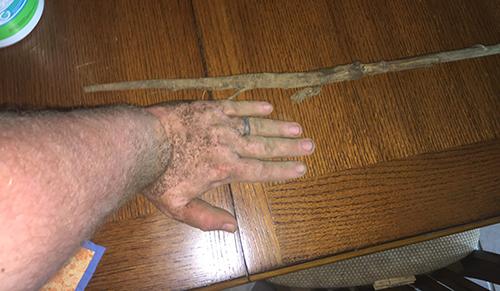
Save the whole plant as most of it can be cooked and eaten.
Preparing the Root
First you will need to separate the root from the rest of the plant.
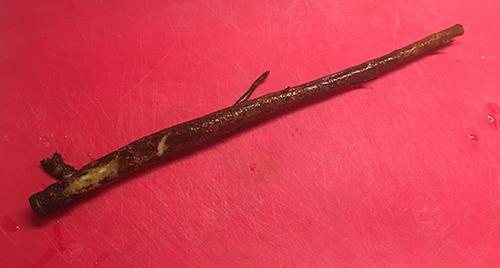
Wash off all of the dirt and then peel the root like a carrot. At this point you can slice it, salt it, and eat it raw if you like. However, cooked burdock root is more common. It can be used in a stir fry, and is popular in Asian cuisine. As you peel the roots, you should place them in a bowl of water with a teaspoon of vinegar to keep them from browning.
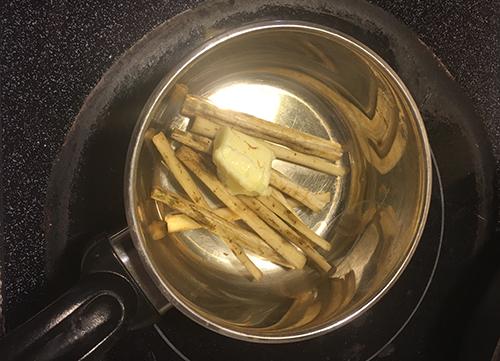
When you are ready to cook the root, julienne it into matchstick pieces and mix with carrots having a similar cut. Heat oil in a frying pan or wok on medium-high heat. Add your root mixture. It takes about five to seven minutes for them to cook. I like to add in a few tablespoons of lemon juice, soy sauce, fish sauce, and honey to give it a sweet and sour flavor. Of course you can also add meat, snap peas, water chestnuts, and other stir fry ingredients.
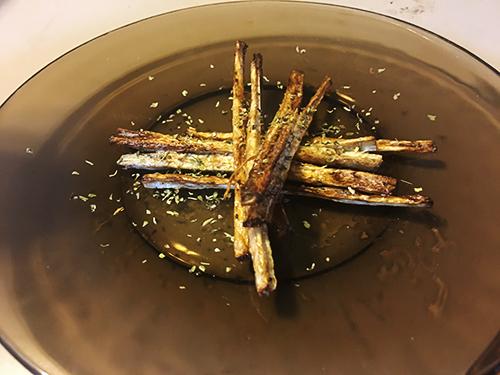
You can also pickle them or make chips.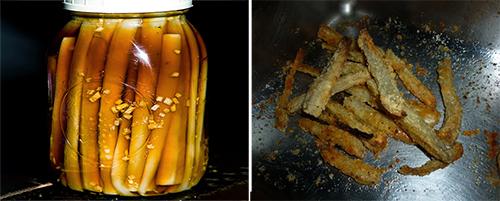
Related: Delicious Recipes Using Cattails; The Supermarket of the Swamp
Preparing the Stems
The primary reason that there have been so many misconceptions regarding the stems of burdock plants is because of the bitter outer skin. It is absolutely nasty and can upset the stomach as well. However, if all of this skin is removed you are left with a very pleasant food source. Once you have removed the root and leaves from the primary stem, you must peel every inch of it. Some people will remove the skinny spines from the actually leaves, peel them, and eat them raw or steam them like asparagus. I typically go after the main stems. Once they are peeled, the raw stem is juicy and crisp like celery.
To cook the stems, I start some butter in a frying pan on medium heat. You want the burdock to caramelize like onions. Cut the stem into one inch pieces, and toss them in the pan. Add some white wine, fennel, and coriander seeds. Salt and pepper to taste. Add a splash of olive oil just as they are browning to give them a nice glaze. As with the roots, you can add carrots and garlic to the mix. Also, soy sauce and miso go very well with the stems. In addition, you can cut them lengthwise and blanch them before sautéing with pasta.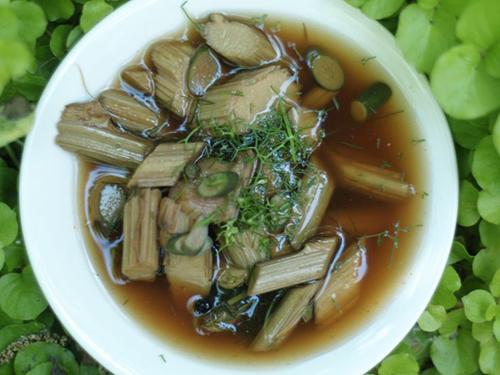
With a little additional knowledge, plants like wild burdock can become an ideal sustainable food source. Even if you live in an urban area, burdock often grows in areas where people do not want it. It is often easy to knock on somebody’s door and ask to harvest some burdock as this disrupts the reproductive cycle to help control the plant. Just use as much of the plant as you can, and be sure not to wipe out a given patch unless the owner of the property insists. While burdock can be incorporated into your normal recipes, I can assure you that knowing how to cook and eat burdock can give you some badly needed nutrients in a survival scenario as well.
You may also like:
 16 Wild Edibles You Didn’t Know You Could Forage For
16 Wild Edibles You Didn’t Know You Could Forage For
This Bug Will Kill Most Americans During The Next Crisis (Video)

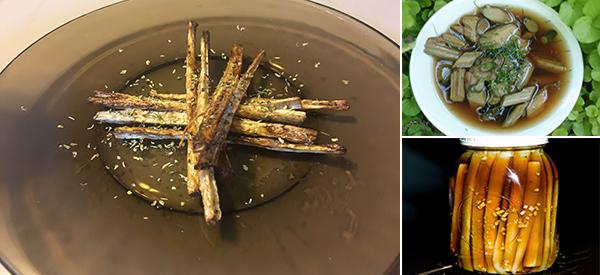













LOL!! Back in the first few years living here on our acreage, I saw this (burdock) weed and thought it was wild rhubarb so I harvested some and made a cobbler out of it. LOL!! So, it was woody and basically ‘bad’, but the sugar saved it. I ate it and hubby laughed at me; so did the neighbors! LOL!!
What would be largest you could harvest a burdock? If I remember right isn’t is a biennial?
I have an out of the way area in the yard where burdock grows. Every winter it dies back and reemerges every spring with a bunch of young plants. Been 17 years in this location and still havent killed it off.
See article below. Burdock/gobo is indeed a biennial. Can’t tell you when is the best time to harvest, although from the article about it remaining in the ground over winter, it would see any time up until it goes to seed would be okay to harvest. Need to do more on line research.
From gardinate.com
“Harvest in the first year when the burdock root is very crisp and has a sweet, mild, and pungent flavour with a little muddy harshness that can be reduced by soaking julienne/shredded roots in water for five to ten minutes. Immature flower stalks may also be harvested in late spring, before flowers appear; the taste resembles that of artichoke, to which the burdock is related.
Inasmuch as the other website stated that burdock flowered in the second year, I would assume that would be the appropriate time to harvest the stalks. Bear in mind that I have zero experience as a burdock farmer and the only information I have is from the internet and we all know how reliable that is. The above quote that I pasted is from an Australian website and talks about growing burdock in Oz.
In Japan burdock is called gobo and is a farm crop. NHK some time back had the commentator visit a gobo farm and he ate raw gobo root fresh from the field. He was amazed at how sweet and juicy it was. I suspect that domesticated gobo is better suited for human consumption than wild gobo. You might want to search on line for gobo seeds or burdock seeds. Offered a choice between the two, I would probably choose gobo as the Japanese have been growing it for as a table crop for well over 100 years.
I copied this from the seedaholic.com website:
“Burdock is native to temperate Europe and Asia and a most popular variety root vegetable in Japan. “Takinogawa” is a special, late-variety burdock that is rich in flavour. This important Japanese vegetable is essential to many classic Japanese dishes including “kimpira,” made with sautéed burdock and carrots. The tap root can be as long as a metre long (36in), they have a texture similar to parsnips and when cooked quickly, retain their crispiness; the outer skin is very thin, similar to carrots.
In England, Burdock is best known as an ingredient in the beverage Dandelion and Burdock, the English equivalent of American root beer. The key flavour profile is anise, perhaps a touch of ginger and spice, but generally a feel of summer, hedgerows and fun!
Burdock is a biennial, producing a rosette of leaves in the first year, then completing its life cycle by flowering and seeding in the second year. Mature plant can reach 3 feet in height. It is easily grown from seed it prefers a deep and sandy garden soil in partial shade or full sun. It may be sown directly from early spring on into summer, with plenty of time left to get a good harvest of roots.
Burdock is the hardiest root vegetable and winters in the garden easily for spring digging. Work the soil deeply for best crop and cook like carrots. Seeds can be sprouted like bean sprouts; nothing goes to waste with this plant.
The picture of the gobo root on the seedaholic.com website shows what the Japanese gobo looks like. It is about 1.5 to 2 inches in diameter and grows to 36 inches in length. It is much more substantial than the root shown in this article. Gobo seeds would make a good seed to stock away in your survival kit.
What an informative and useful article! Changes my whole attitude toward what I thought was an awful weed. (May not change my furry dog’s attitude toward the burrs in his ears.) How exciting to find that this “weed” is so useful and easy to grow! Thanks for the additional homework, l.c. chuck!
And one more copied comment from garden guides.com
“Learn to positively identify burdock if you are harvesting it in the wild and are not growing it in a garden setting. Burdock grows up to 7 feet tall and has large, arrow-shaped leaves on thick stalks. The root is fat and deep. Mature plants produce spiky purple flowers similar to thistles and seed burrs that stick to clothing or fur. Always consult multiple sources to verify an identification before eating any wild plant. Most field guides to wild edibles should provide you with more information and illustrations for identifying wild burdock root.
Locate young burdock plants to dig. Burdock is a biennial, and the root become woody and unappetizing after the first year. Choose first-year burdock plants with only a rosette of leaves near the ground. Avoid plants with flowers or a flower stalk. First- year burdock root may be harvested in the summer or fall.
Dig a hole next to the burdock you wish to harvest. Begin digging a few inches away from the burdock stalk and dig down at least 1 foot. Burdock roots may be 2 or more feet long. Loosen the soil next to the root with your fingers or a hand trowel.
Press the shovel into the soil next to the burdock root on the opposite side of the hole you dug. Lean into the shovel to push the burdock root out of the hole.
Trim off leaves and feeder roots and rinse well. Do not peel. Store fresh burdock root in the refrigerator for a week or more to use as a food, or slice it thinly and dry it in a dehydrator or low oven to use medicinally.”
This article also stated that burdock was used as a treatment for acne.
My burdock looks much bigger than your pictures. How about Curly Dock? It has a very large tap root.
Recalling the NHK video journal on the burdock farm in Japan, the plants were at least waist high on the announcer and farmer and the root when they extracted it was at least 30 inches in length and at the top was about 2 – 2.5 inches in diameter. They cut the burdock fresh from the ground and ate it raw, not bothering to peel it. I didn’t pay especially close attention to the video because at that moment I didn’t realize that burdock grew in the U.S. as a wild plant. One of these days they may run it again and I will pay more attention to it.
A relative of mine in Japan says that burdock (gobo) is a popular dish and is usually prepared with carrots in a dish called chimpira which they serve frequently. Gobo is available at every green grocery store. Local Japanese stores are still divided by what they sell. There is the green grocer, the fish market, the rice store, the fruit store, the bread/bakery store, the noodle shop etc. As in many European countries the Japanese household shops daily for food with the exception of rice. Typically, although food is more expensive in Japan, the Japanese insist on blemish free, absolutely fresh food. The gobo that one buys today in the green grocer was picked late yesterday and rushed overnight to the wholesaler who sold it before dawn to the retailer. Tomorrow if it is not sold it will go in the recycle can. I have seen peaches as high as $20 per peach but it was the size of a large grapefruit and you have never in your life tasted anything so sweet and juicy. Eating such a peach provides a gustatory sensation that is indescribable.
Be very careful eating plants without positive id. I have always known cocklebur to be inedible. It is not what I have always known as burdock. Here’s an article on cocklebur: http://www.indefenseofplants.com/blog/2017/9/17/understanding-the-cocklebur
Burdock has been secretly planted in scret patches for hundreds of years. My son just purchased a house & the perimeter of his entire back yard is covered with it. To me, that is heaven. The root is one of the most highly sought out delicacy known to this world & prized throughout however I’ll never personally destroy a patch of Burdock for eating it’s root. In the old Italian neighborhoods, burdock was called GARDOONS, and when they were plated it was like a festival. Just about every other food would be pushed aside to eat these first. The leaves, like that of rhubarb, contains oxilic acid, which is poisonous, however the stems of both plants can be eaten any time of the year. My grandmother used to peel the stems, turning her hands black as the stems are loaded with iron & other nutrients. She used to cut the large diameter stems, dip them into batter, then fry them in olive oil. This was about 5 times more delicious than eating the prized artichoke heart, one of my most favorite foods in the world. With burdock I flavor dream. God I miss grandma however I’ve been planting burdock patches everywhere. All are secret locations, which is tradition, as most just see it as a nusiance.
Your pop-in ad is annoying.